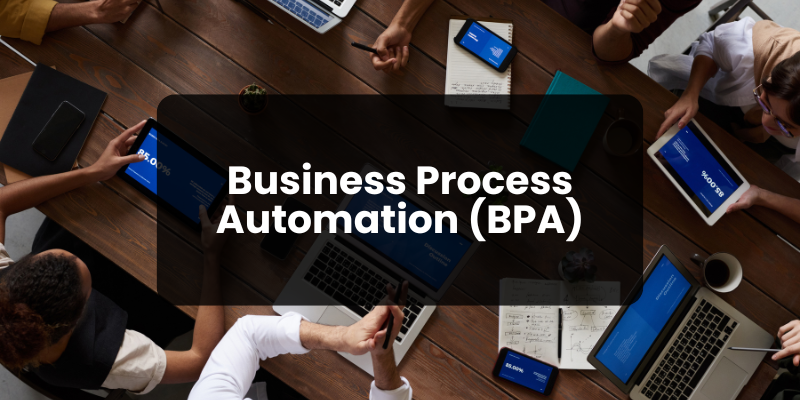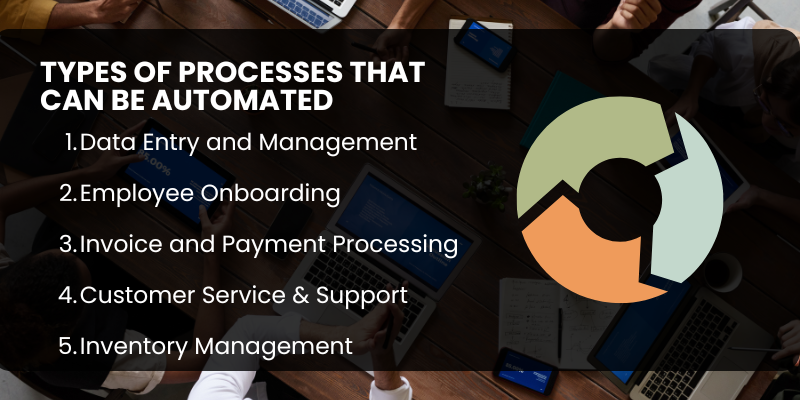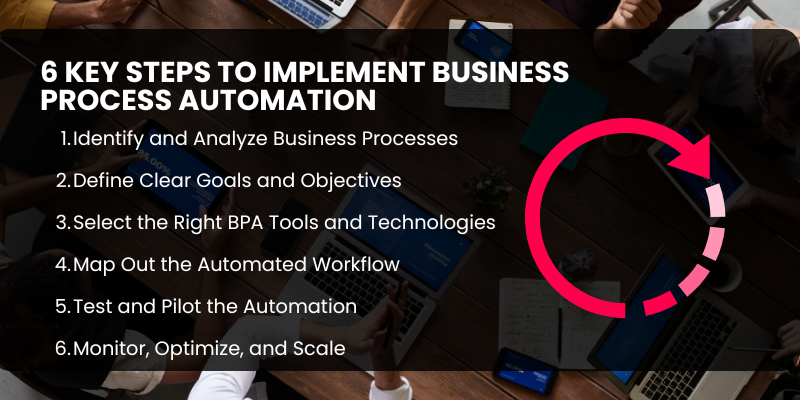Business process automation (BPA) involves using technology to automate complex business workflows, reducing the need for manual input.
Tasks like data entry, approvals, and communication are streamlined, ensuring efficiency and accuracy in operations.
According to Gartner, Bill Gates once said, “Automation applied to an efficient operation will magnify the efficiency.”
In today’s business landscape, what is business process automation, and why is it vital for improving productivity, minimizing errors, and speeding up business cycles in important.
Thus, by automating routine processes, organizations can achieve higher efficiency, adapt to market changes quickly, and improve customer experiences, especially in competitive industries like retail, where understanding what are five marketing strategies that retailers spend half of their annual budget on? can help align automation with marketing goals.
BPA also plays a critical role in digital transformation by reducing costs, increasing scalability, and enabling operational agility.
In 2025, the global BPA market is projected to reach $19.6 billion, growing at a CAGR of 12.2% from 2020, driven by demand for process automation technology and AI business process automation.
What is Business Process Automation (BPA)?
Business Process Automation (BPA) is the use of technology to automate complex business processes and tasks, which would typically require human intervention.

BPA integrates software solutions into existing business systems to streamline workflows, optimize processes, and reduce manual work, similar to how digital marketing services streamline online campaigns for brands looking to reach a broader audience.
It encompasses tasks such as data management, approvals, reporting, and customer interactions.
The Core Functions of BPA include
- Automation of Repetitive Tasks: BPA handles routine tasks, like data entry and document processing, freeing up employees to focus on higher-value work.
- Workflow Optimization: By automating workflows, BPA ensures that processes are executed faster, with fewer errors and delays.
- Data Integration: BPA integrates data from various systems, ensuring that relevant information is accessible for decision-making
Explore Our Digital Marketing Services!
5 Types of Processes that Can Be Automated
Various business processes, such as data entry, employee onboarding, invoice processing, customer support, and inventory management, can be automated to improve efficiency and reduce errors.
Various types of automation include:

1. Data Entry and Management
Automating data input and management tasks helps eliminate errors and save time, ensuring accurate and timely data entry across various systems without the need for manual intervention.
2. Employee Onboarding
HR processes like recruitment, document verification, and system access creation can be automated, making the onboarding experience smoother and more efficient for both new hires and HR teams.
3. Invoice and Payment Processing
Automating financial processes such as invoice generation, approval workflows, and payment processing helps reduce delays, ensure accuracy, and speed up the payment cycle, improving cash flow management.
4. Customer Support and Service Requests
Using automation tools like chatbots or ticketing systems can handle routine customer inquiries, process service requests, and provide instant solutions, improving response time and customer satisfaction.
5. Inventory Management
Automating inventory tracking, order management, and restocking processes helps businesses maintain optimal stock levels, reduce human error, and improve supply chain efficiency, leading to better decision-making and reduced costs.
Benefits of Business Process Automation
Business process automation increases efficiency, reduces costs, improves accuracy, improves customer experience, and ensures compliance, driving operational excellence.
The following are the main benefits of BPA:
- Increased Efficiency: Automating time-consuming tasks frees up resources, allowing employees to focus on higher-value activities and speeding up overall operations.
- Cost Reduction: By minimizing errors and reducing the need for manual labor, BPA lowers operational costs, improving the bottom line.
- Improved Accuracy: Automation ensures consistent quality by reducing human error, leading to more reliable outcomes in processes like data entry and reporting.
- Enhanced Customer Experience: BPA allows for faster response times and more efficient service delivery, leading to improved customer satisfaction and loyalty.
- Compliance and Risk Management: BPA helps ensure that business processes comply with regulations, reducing the risk of non-compliance and mitigating potential legal and financial risks.
How BPA Contributes to Digital Transformation?
Business Process Automation (BPA) plays an important l role in helping organizations achieve agility and adaptability in today’s fast-paced business environment, much like businesses learning how to measure brand awareness to align their transformation goals with customer perceptions.
By automating repetitive and time-consuming tasks, BPA allows businesses to respond quickly to changes in the market, customer demands, and internal processes.
For example, automation enables faster decision-making by providing real-time data and insights, ensuring that businesses can pivot or adjust strategies as needed without being hindered by slow manual workflows.
Additionally, BPA helps break down organizational silos, creating more seamless communication and collaboration between departments, ultimately leading to quicker and more effective responses to evolving challenges.
Digital Transformation agencies like Centric often integrates BPA with broader strategies such as SEO ranking report software, content marketing tools, and web design and development services to help companies optimize workflows and accelerate digital transformation.
Explore Our Digital Transformation Services!
6 Key Steps to Implement Business Process Automation
Implementing business process automation involves identifying suitable processes, selecting the right tools, integrating automation into workflows, and continuously monitoring and optimizing performance.

1. Identify and Analyze Business Processes
Before automating any process, it's essential to identify the processes that could benefit from automation.
Start by analyzing existing workflows to determine which tasks are repetitive, time-consuming, or prone to human error.
Focus on processes that have a clear structure and involve a lot of manual work, such as data entry, approvals, or customer service interactions, just as marketers focus on how to search a word on a website to analyze and optimize website content during SEO audits.
Once identified, document these processes thoroughly to understand the flow of activities and potential bottlenecks.
2. Define Clear Goals and Objectives
For successful BPA implementation, it's crucial to define what you want to achieve.
This could be reducing manual errors, speeding up a specific process, improving customer satisfaction, or cutting costs.
Setting measurable goals helps you track the effectiveness of the automation and ensures the solution addresses the right business needs.
For example, you might set a goal to reduce the time spent on a particular task by 50% or increase productivity in a specific department.
3. Select the Right BPA Tools and Technologies
Choosing the right business process automation tools is critical. Depending on the type of processes you're automating, the tools you select should be able to integrate with your existing systems.
Look for solutions that offer scalability, user-friendly interfaces, and good support.
Popular BPA tools include robotic process automation (RPA), workflow automation software, and AI-driven platforms that can automate decision-making processes, similar to SEO ranking report software that automates keyword tracking and performance reporting for marketing teams.
Assess each tool's features, capabilities, and compatibility with your infrastructure to ensure a smooth integration. For example, tools like UiPath, Automation Anywhere, and Microsoft Power Automate are widely used for their robust integration and scalability.
4. Map Out the Automated Workflow
Once you've selected the right tools, the next step is to map out the automated workflows.
This involves creating a detailed flowchart or diagram that outlines how the automation will operate, much like step-by-step guides such as how to use AI in photoshop that walk users through complex digital processes.
It’s important to include all steps in the process, including triggers, data transfers, approvals, and notifications.
This step helps visualize the entire workflow, ensuring that every part of the process is automated correctly and that no steps are skipped.
It also allows you to identify potential inefficiencies and optimize the workflow before automation.
5. Test and Pilot the Automation
Before fully implementing BPA across the organization, it’s essential to test the automation on a smaller scale.
Start with a pilot program or a specific department to ensure the automation works as expected.
During the testing phase, monitor the performance and collect feedback from users to identify any issues or areas for improvement.
Testing ensures that the system functions smoothly, reduces the risk of operational disruption, and gives you the opportunity to fine-tune the automation.
6. Monitor, Optimize, and Scale
After the initial deployment, continuous monitoring is key to ensuring the automation is delivering the desired results. Track key performance indicators (KPIs) such as time savings, cost reductions, and error rates to evaluate the impact of BPA.
Over time, you may identify new opportunities for improvement or areas where the automation can be scaled. Regular optimization ensures that your automated processes stay aligned with evolving business needs and technological advancements.
Additionally, as your business grows, the business process automation platform should be flexible enough to scale across more processes or departments.
3 Main Challenges in BPA Implementation
Implementing BPA can face challenges such as employee resistance, integration issues with existing systems, and concerns over data security and privacy.
1. Resistance to Change from Employees
Employees may resist BPA implementation due to concerns about job security or a fear of adopting new technologies. Overcoming this challenge requires clear communication, training, and involving employees in the process to ensure they understand the business process automation benefits.
2. Integration Issues with Existing Systems
Integrating BPA with legacy systems or other business applications can be complex, leading to potential compatibility issues. Choosing business process automation solutions that are compatible with existing software and ensuring proper integration planning is essential for a smooth transition.
3. Ensuring Data Security and Privacy
Automating processes often involves handling sensitive data, which raises concerns about data security and privacy. Implementing strong encryption, access controls, and compliance with data protection regulations is essential to safeguard business and customer information during automation.
The Future of Business Process Automation
The future of business process automation is being shaped by emerging trends like Artificial Intelligence (AI), Machine Learning (ML), and Hyperautomation.
AI business process automation and ML are enhancing BPA by enabling systems to learn from data and make more intelligent, dynamic decisions, fueling the ongoing AI vs human debate about the future of work, while Hyperautomation aims to automate entire business workflows.
As process automation technology evolves, BPA will continue to play a critical role in business by automating more complex tasks, enabling real-time decision-making, and improving operational agility.
These advancements will allow businesses to remain competitive by optimizing processes, enhancing customer experiences, and driving innovation across various industries, , especially for companies leveraging web design and development services to build strong digital ecosystems.
Business Process Automation Examples and Tools
To accelerate how to automate business processes, here are practical examples and tools that enhance efficiency:
-
Marketing Automation: A retail company used business process automation software like HubSpot to automate email campaigns, segmenting customers based on purchase history. This led to a 25% increase in email open rates and a 15% boost in sales within six months.
-
Sales Pipeline Management: A B2B firm implemented Salesforce to automate lead tracking and follow-ups, reducing manual data entry by 40% and shortening the sales cycle by 20%.
-
IT Service Desk: Using ServiceNow, a tech company automated ticket routing and resolution, cutting response times by 30% and improving employee satisfaction.
Popular Business Process Automation Tools:
-
UiPath: A leading RPA platform for automating repetitive tasks like data entry.
-
Automation Anywhere: Offers cloud-based solutions for complex workflows.
-
Microsoft Power Automate: Integrates with Microsoft 365 for seamless automation.
-
Zapier: Simplifies task automation for small businesses by connecting apps.
These examples and tools show how business process automation solutions can drive measurable results across industries.
FAQs:
What is the difference between RPA and BPA?
RPA (Robotic Process Automation) uses software robots to automate repetitive tasks, while BPA (Business Process Automation) focuses on automating entire business processes, integrating workflows, and improving efficiency across multiple systems.
What are the 4 stages of process automation?
- Manual process: Tasks are done manually.
- Automated tasks: Repetitive tasks are automated.
- Workflow automation: Multiple tasks are automated as part of a workflow.
- Business process optimization: Automation integrates across systems for efficiency and continuous improvement.
What is the main purpose of business process automation (BPA) in enterprises?
BPA aims to streamline business processes, reduce errors, improve efficiency, and free up employees from manual tasks, enabling them to focus on higher-value work.
What is the difference between business automation and process automation?
Business automation is the broad use of technology to automate various business functions, whereas process automation specifically targets automating workflows and tasks within a defined business process.
Book Your Free Expert Consultation!
Conclusion
What Is Business Process Automation (BPA)? It refers to the use of technology to automate repetitive and complex tasks within a business, including increased efficiency, cost reduction, improved accuracy, and enhanced customer experience.
By automating repetitive and complex tasks, organizations can streamline operations, reduce errors, and drive innovation, ultimately leading to better performance and competitive advantage.
As digital transformation continues to reshape industries, it’s crucial for organizations to adopt BPA to stay ahead of the curve, improve operational processes, and embrace future-ready technologies that enhance scalability and adaptability in an ever-evolving market.









